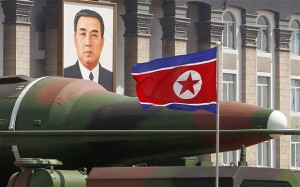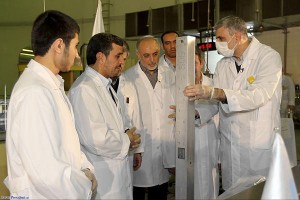2013-05-30 By Ed Timperlake
It is now time to focus on evolving U.S. military force structure and technology in response to what Professor Paul Braken has identified in a seminal work as: “the challenge of deterrence in the second nuclear age.”
We had a chance to interview Professor Braken and we discussed his approach:
SLD: Your book although entitled The Second Nuclear Age is about strategy in a world of nuclear proliferation. It is about deterrence in a very different nuclear world than one shaped by the competition and the rules shaped by the two nuclear superpowers.
Bracken: It is. What I wanted to do was to shift the debate. There are many, many studies of books about deterrence, but deterrence really needs to be broken up into what I would call smaller chunks, which really gets into the subject of escalation and de-escalation. I don’t think it’s possible to talk about deterrence and not talk about escalation and de-escalation.
Soon after Professor Braken’s book came out, Barry Watts, formerly of the Office of Net Assessment (OSD) published “Nuclear-Conventional Firebreaks and the Nuclear Taboo” (CSBA), in which he concludes that there is the possibility that “limited use of low-yield nuclear weapons will become the new normal.”

Col. Watts USAF (ret) arrives at the same intellectual point that Professor Bracken has of “.. a second nuclear age whose dangers and uncertainties will dwarf those of the first” Taken together they are foundation documents for further analysis, diplomacy and most importantly a U.S. 21st Century military strategy and the resulting force structure.
For arguments sake and focus, this paper excludes the US Vs USSR (now Russia) previous Cold War Counterforce (CF)/Countervalue deterrence (CV) equation, and also the US V Peoples Republic of China (PRC) in that same formula.
The US/PRC deterrence equation can also be understood even if the Georgetown University “Great Wall” study’s insightful findings are made real: Most of the attention (Great Wall Study) has focused on the 363-page study’s provocative conclusion — that China’s nuclear arsenal could be many times larger than the well-established estimates of arms-control experts.
A WMD exchange between India and Pakistan is also not inside this papers scope, except if somehow a Pakistan device winds up in the hands of fanatics.
Finally, in a State-to-State deterrence equation with the North Korean Dear Leader it can be addressed with countrforce/countervale deterrence.
Professor Bruce Bechtol has an important new book (The Last Days of Kim Jong-IL), in which he astutely discusses the transition from Dear Leader Kim Jong-IL to Dear Leader Kim Jung Un. In his book Professor Bechtol touches on the possibly of both an asymmetric North Korea attack for example with a nuke device delivered by “A merchant ship or fishing trawler..” In this situation US/Allied counterforce response would be appropriate to decapitate that regime.
Dr. Bethel also has a section devoted to possible proliferation from the newest Dear Leader in support of terrorism. He concludes with a profoundly important question, “ Given the large amount of available evidence, one wonders why the U.S. (at least of this writing May 2013) has not restored North Korea to its State Department list of state sponsors of terrorism.” Which is can be seen as a huge symbolic failure of U.S. Diplomacy and resolve noticed through out Asia.
Focusing on a terrorist bomb is a very nasty problem. A device in the hands of stateless fanatical Islamic killers is a global nightmare because they have continually demonstrated a ruthless counter value targeting strategy in the name of their religious beliefs.
Their global attacks from a nightclub in Asia, to New York, Arlington VA, Boston, London and Spain were very specific. They had a ruthless intent to employ conventional explosives to maximize innocent civilian deaths.
So why would they not use a nuke device to kill even more?
The CF/CV dilemma is that they have little territory to hold hostage to any counterforce decapitation strategy. And if any country responded to attack their location they would probably hope for a reactive nuke strike and consider that an even greater success.
The biggest problem on the horizon in terrorism is an Iranian Device. The leadership of Iran is now beginning to see a public discussion that they can be contained and held hostage if they announce they have a workable and eventually weaponized atomic bomb. Perhaps, but looking at their affinity for a belief system that encourages conversion or death, and especially death to Israel, it is not a bet the world can afford to take and Israel will rightly not allow.
A 21st Century U.S. military technology solution can be the beginning of art of the possible in trying to identify and stop loose nukes. The US and its Allies have conventional forces interconnected around the globe and that scalable military presence is a solid foundation to build on.
The USAF, in addition to being an airpower offensive combat force, has evolved into being a very powerful ISR force. This is a significant step in the right direction.
Deterrence in this the second nuclear age can embrace conventional forces into a defense/offensive force against loose nukes.
By focusing on empowering air breathing sensor assets with conventional global strike the USAF can pioneer becoming a credible ISR detection and strike force.
The U.S. should as well bring along the Allies and encourage intelligence sharing.
By building on the current layered passive defense in order to integrate that capability with a global highly accurate conventional offensive strike capability, an attack defense enterprise can be built that would deal with the kind of deterrence necessary in the second nuclear age.
Perhaps the best analysis today on layered sensing is still a CRS report from March 25, 2009 by Dana A. Shea “The Global Nuclear Detection Architecture, issue for Congress.”
A layered, defense-in-depth approach to global nuclear detection architecture was recommended by the Defense Science Board when considering how to protect DOD assets against unconventional nuclear threats. Successful application of a layered defense provides multiple opportunities to detect and interdict threats. According to DNDO, “It is recognized that no single layer of protection can ever be one hundred percent successful,” and a layered defense strategy acknowledges this difficulty.19 If one sublayer fails to detect a threat, the next may succeed.
Finally, the nature of the terrorist nuclear threat, potentially a changing threat based on an intelligent adversary, implies that any metrics and methodology developed to assess the global nuclear detection architecture’s effectiveness will need to evolve as the threat does.
When advances in technology, new intelligence information, and other factors are considered, the effectiveness of the global nuclear detection architecture may need to be judged on active testing or “red teaming” of the architecture.
The initial U.S. DOD research focus should be to look at layers of “Global Nuclear Detection Architecture” which logically is always iterative and dynamic in constantly improving sensor/detection technology while also respecting an enemy that is cleaver, reactive and ruthless.

If given significant attention a 21st Century military conventional force can have a strategic role in stopping loose nukes. This is actually not expensive if built into the attack defense enterprise itself.
The US national command authority should embrace a framework of conventional forces having a strategic deterrence to sense, identify and stop the kind of nuclear threat where counter value by itself will not deter.
The USAF with global precision strike, in partnership with US Navy Carrier aviation and patrol assets such as the new P-8, can focus on sensor strike conops . Additionally, Special Forces and the USN/USMC Expeditionary Strike Group (ESG) can be looked at to insert quickly boots on the ground to follow up a precision strike mission or engage residual forces and gather intelligence.
Globally with little additional expense, since we are doing it right now for conventional combat engagements, a bridge between intelligence sharing, ISR “sensor” upgrades and conventional presence and readiness all comes together.
It is about admitting the problem and configuring forces to deal with it. It is not about preparing for the next great land war.
Rather than sit in CONUS and posture diplomatic signaling or only having an escalation formula, a conventional force can escalate and de-escalate quickly.
Setting conventional forces against a stateless nuke threat maybe an extremely prudent approach. It is not provocative because our allies are always forwarded deployed so to speak and we continue to have significant global presence.
Tasking conventional forces to deter a terrorist nuke can be seen as a coherent move against worldwide proliferation inside the art of the possible.
One simple example in the Afghan draw down, US air assets operating on the roof of the world astride the historic “silk road” allows for sensor presence to address any attempt to proliferate nukes, over that path, into terror networks.
Another example, this time at sea is that USN maritime patrolling is always ongoing.
And the recent successful Hypersonic Cruise Missile (HSCM) test will eventually allow very rapid precision strike when time might be of the utmost importance even better if it fits into an F-35 weapons bay. It is not always all about China.
It is an open-ended challenge to fight a ruthless death loving enemies and offensive and defense technology will have limitations, but technology is always improving. Consequently, this is not in any way meant to a conclusion of the subject, but just a small contribution to a much need public debate.

